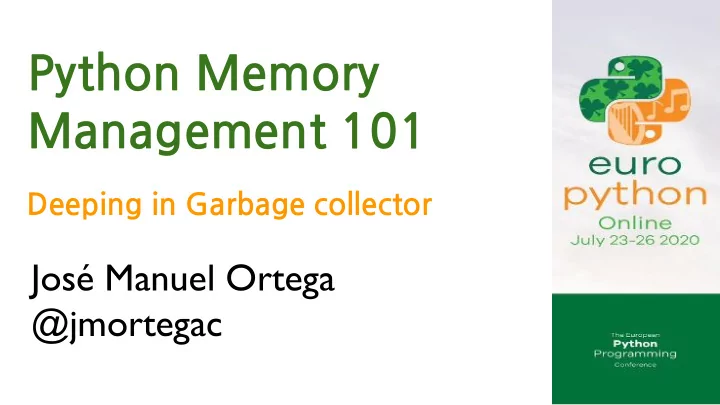

Python�Memory� Management�101 Deeping�in�Garbage�collector José Manuel Ortega @jmortegac
About�me ● @jmortegac ● http://jmortega.github.io ● https://www.linkedin.com/in/jmortega1/
Agenda ● Introduction�to�memory�management ● Garbage�collector�and�reference� counting�with�python ● Review�the�gc�module�for�configuring� the�python�garbage�collector ● Best�practices�for�memory�managmen t
Introduction�to�memory�management ● Memory�management�is�the�process�of� efficiently�allocating,�de-allocating,�and� coordinating�memory�so�that�all�the� different�processes�run�smoothly�and�can� optimally�access�different�system� resources.
Python�Objects�in�Memory
Python�Memory�Manager
Heap�allocation
Heap�allocation def main(): x=300 print(id(x)) w=fun(x) print(id(w)) def sqr(x): print (id(x)) z=x*x print(id(z)) return z if __name__ == "__main__": main()
Python�Objects�in�Memory ● Each�variable�in�Python�acts�as�an�object ● Python�is�a�dynamically�typed�language� which�means�that�we�do�not�need�to� declare�types�for�variables.
Python�Objects�in�Memory
Python�Objects�in�Memory
Python�Objects�in�Memory
Python�Objects�in�Memory
id()�method
id()�method
id()�method
is�Operator
Reference�counting ● Python�manages�objects�by�using�reference� counting ● Reference�counting�works�by�counting�the� number�of�times�an�object�is�referenced�by� other�objects�in�the�application. ● When�references�to�an�object�are�removed,� the�reference�count�for�an�object�is� decremented.
Reference�counting ● A�reference�is�a�container�object�pointing�at another�object. ● Reference�counting�is�a�simple�technique in�which�objects�are�allocated�when�there�is reference�to�them�in�a�program
Reference�counting ● when�reference�count�increases? ○ x=1 ○ def(x): ○ list.append(x)
Reference�counting
Reference�counting
Reference�counting
Reference�counting ● Easy�to�implement ● Objects�are�immediately�deleted�when� reference�counter�is�0 ✗ �Not�thread-safe ✗ �Doesn’t�detect�cyclic�references ✗ �space�overhead�-�reference�count�is� stored�for�every�object
Garbage�collector(GC)�module
Python�Garbage�collector ● Reference�Counting�+�Generational�GC ● RefCount�reaches�zero,�immediate� deletion ● Deleted�objects�with�cyclic�references� are�deleted�with�Tracing�GC
Garbage�collector(GC)�reference�cycle
Garbage�collector(GC)�reference�cycle >>> def ref_cycle(): ... list = [1, 2, 3, 4] ... list.append(list) ... return list
Garbage collector(GC) reference cycle import gc for i in range(8): ref_cycle() n = gc.collect() print("Number of unreachable objects collected by GC:", n) print("Uncollectable garbage:", gc.garbage) print("Number of unreachable objects collected by GC:", gc.collect())
Garbage collector(GC) reference cycle
Python�Object�Graphs https://mg.pov.lt/objgraph/ import objgraph x = "hello" y = [x, [x], list(x), dict(x=x)] objgraph.show_refs([y], filename='sample-graph.png')
Best�practices�for�memory�management ● Using�gc.collect()�carefully print("Collecting...") n = gc.collect() print("Number of unreachable objects collected:", n) print("Uncollectable garbage:", gc.garbage)
Garbage collector(GC) methods
Best�practices�for�memory�management ● Using�with�context�manager�for�working� with�files with open('data.txt', 'r') as file: data = ','.join(line.strip() for line in file)
Best�practices�for�memory�management ● Avoid�List�Slicing�with�[:] list= [1,2,3,4] list[1:3] list[slice(1,3)]
Best�practices�for�memory�managment ● String�Concatenation string= “hello” string+= “world” wordList = ("hello", "world") string = " ".join(wordList)
Best�practices�for�memory�management ● Use�Iterators�and�Generators
References ● https://stackabuse.com/basics-of-memory-management-in-p ython/ ● https://realpython.com/python-memory-management https://rushter.com/blog/python-garbage-collector ● ● https://pythonchb.github.io/PythonTopics/weak_references. html
https://www.youtube.com/c/JoseManuelOrtegadev
Recommend
More recommend